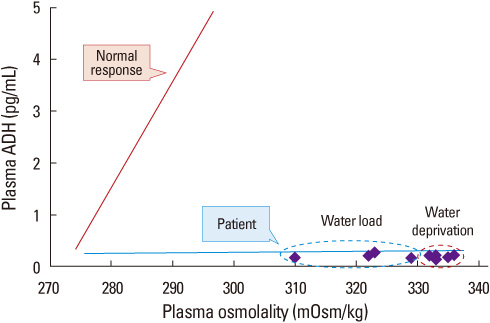Endocrinol Metab.
2012 Sep;27(3):232-236. 10.3803/EnM.2012.27.3.232.
A Case of Adipsic Hypernatremia Associated with Anomalous Corpus Callosum in Adult with Mental Retardation
- Affiliations
-
- 1Department of Internal Medicine, The Catholic University of Korea College of Medicine, Seoul, Korea. junpearl19@catholic.ac.kr
- KMID: 2282408
- DOI: http://doi.org/10.3803/EnM.2012.27.3.232
Abstract
- Adipsic hypernatremia cause chronic hyperosmolality and hypernatremia through a combination of impaired thirst and osmotically stimulated antidiuretic hormone secretion. This syndrome can be grouped together as disorders of osmoreceptor dysfunction due to the various degrees of osmoreceptor destruction related with different types of intracranial lesions around the anterior hypothalamus, consistent with the location of primary osmoreceptor cells. Adipsic hypernatremia, associated with developmental disorder of corpus callosum, is very rare. Most cases are diagnosed at infancy and early childhood; the replacement of desmopressin is necessary. Herein, we report adipsic hypernatremia associated with anomalous corpus callosum in adult with mental retardation; they were treated with only free water without desmopressin.
Keyword
MeSH Terms
Figure
Reference
-
1. Hiyama TY, Watanabe E, Okado H, Noda M. The subfornical organ is the primary locus of sodium-level sensing by Na(x) sodium channels for the control of salt-intake behavior. J Neurosci. 2004. 24:9276–9281.2. Radetti G, Rizza F, Mengarda G, Pittschieler K. Adipsic hypernatremia in two sisters. Am J Dis Child. 1991. 145:321–325.3. Schaff-Blass E, Robertson GL, Rosenfield RL. Chronic hypernatremia from a congenital defect in osmoregulation of thirst and vasopressin. J Pediatr. 1983. 102:703–708.4. Masera N, Grant DB, Stanhope R, Preece MA. Diabetes insipidus with impaired osmotic regulation in septo-optic dysplasia and agenesis of the corpus callosum. Arch Dis Child. 1994. 70:51–53.5. Karabay-Bayazit A, Herguner O, Altunbasak S, Noyan A, Yukel B, Anarat A. Hypodipsia-hypernatremia syndrome associated with holoprosencephaly in a child: a case report. Turk J Pediatr. 2002. 44:263–266.6. Komatsu H, Miyake H, Kakita S, Ikuta H. Hypoplasia of the corpus callosum associated with adipsic hypernatremia and hypothalamic hypogonadotropinism: a case report and review of the literature. Pediatr Int. 2001. 43:683–687.7. Baylis PH, Thompson CJ. Osmoregulation of vasopressin secretion and thirst in health and disease. Clin Endocrinol (Oxf). 1988. 29:549–576.8. Thrasher TN, Keil LC, Ramsay DJ. Lesions of the organum vasculosum of the lamina terminalis (OVLT) attenuate osmotically-induced drinking and vasopressin secretion in the dog. Endocrinology. 1982. 110:1837–1839.9. Brenner BM, Rector FC. Brenner and Rector's the kidney. 2007. 8th ed. Philadelphia: Saunders.10. Teelucksingh S, Steer CR, Thompson CJ, Seckl JR, Douglas NJ, Edwards CR. Hypothalamic syndrome and central sleep apnoea associated with toluene exposure. Q J Med. 1991. 78:185–190.11. Mavrakis AN, Tritos NA. Diabetes insipidus with deficient thirst: report of a patient and review of the literature. Am J Kidney Dis. 2008. 51:851–859.12. Volpe P, Campobasso G, De Robertis V, Rembouskos G. Disorders of prosencephalic development. Prenat Diagn. 2009. 29:340–354.13. Grossman RA, Hamilton RW, Morse BM, Penn AS, Goldberg M. Nontraumatic rhabdomyolysis and acute renal failure. N Engl J Med. 1974. 291:807–811.14. Opas LM, Adler R, Robinson R, Lieberman E. Rhabdomyolysis with severe hypernatremia. J Pediatr. 1977. 90:713–716.15. Robertson GL, Aycinena P, Zerbe RL. Neurogenic disorders of osmoregulation. Am J Med. 1982. 72:339–353.16. Halter JB, Goldberg AP, Robertson GL, Porte D Jr. Selective osmoreceptor dysfunction in the syndrome of chronic hypernatremia. J Clin Endocrinol Metab. 1977. 44:609–616.17. Block LH, Furrer J, Locher RA, Siegenthaler W, Vetter W. Changes in tissue sensitivity to vasopressin in hereditary hypothalamic diabetes insipidus. Klin Wochenschr. 1981. 59:831–836.18. Smith D, McKenna K, Moore K, Tormey W, Finucane J, Phillips J, Baylis P, Thompson CJ. Baroregulation of vasopressin release in adipsic diabetes insipidus. J Clin Endocrinol Metab. 2002. 87:4564–4568.19. DeRubertis FR, Michelis MF, Beck N, Field JB, Davis BB. "Essential" hypernatremia due to ineffective osmotic and intact volume regulation of vasopressin secretion. J Clin Invest. 1971. 50:97–111.20. Vokes TJ, Robertson GL. Disorders of antidiuretic hormone. Endocrinol Metab Clin North Am. 1988. 17:281–299.
- Full Text Links
- Actions
-
Cited
- CITED
-
- Close
- Share
- Similar articles
-
- Adipsic Hypernatremia after Clipping of a Ruptured Aneurysm in the Anterior Communicating Artery: A Case Report
- Agenesis of Corpus Callosum
- Intracrainal huge lipoma of the corpus callosum
- A Case of Acrocallosal Syndrome with Developmental Delay: A case report
- A Case of Diffuse Cerebral Cortical Dysplasia and Partial Agenesis of Corpus Callosum in Seckel Syndrome



